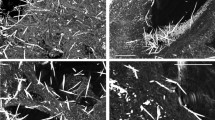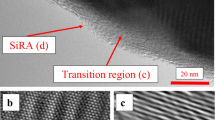Abstract
Crocidolite asbestos fibres, suspended in physiological saline, were injected subcutaneously into one or both flanks of 95 CBA/Lac female mice; 75 control mice received injections of saline only. Most animals were killed at chosen intervals of between 2 and 42 days after injection but some were left for longer periods of up to 623 days. At autopsy, many lymphoid and non-lymphoid structures were removed and examined for the presence of asbestos by the following techniques: haematoxylin and eosin staining followed by conventional and polarized light microscopy; Perl's stain; microincineration followed by phase-contrast microscopy; maceration with KOH followed by phase-contrast microscopy; and electron microscopy.
A combination of haematoxylin and eosin staining and microincineration was found to be the most convenient and reliable method for demonstrating asbestos fibres in the tissues. Electron microscopy was essential for detecting very small fibres and for locating them to specific intracellular structures.
The morphological findings indicate that some migration of asbestos fibres away from the initial site of injection takes place. Dissemination is usually along lymphatic pathways and fibres tend to accumulate in the lymphoid tissues, particularly in the regional (axillary) lymph nodes; smaller amounts were found in inguinal, mediastinal and lumbar nodes. The fibres were usually intracellular, lying inside the phagosomes of macrophages, but larger fibres weresometimes encountered lying free. Small numbers of fibres were seen in the spleen and also in non-lymphoid organs such as the liver, kidneys and brain—suggesting that some asbestos may enter the blood stream. There was no evidence of massive or selective spread to subserosal tissues in the thorax or abdomen, though trapping of asbestos fibres was observed in pleural “milky spots” in long-term survivors. The possible role of milky spots in the development of pleural plaques and mesotheliomata is discussed.
This is a preview of subscription content, access via your institution
Access options
Subscribe to this journal
Receive 24 print issues and online access
$259.00 per year
only $10.79 per issue
Buy this article
- Purchase on Springer Link
- Instant access to full article PDF
Prices may be subject to local taxes which are calculated during checkout
Similar content being viewed by others
Rights and permissions
About this article
Cite this article
Kanazawa, K., Birbeck, M., Carter, R. et al. Migration of Asbestos Fibres from Subcutaneous Injection Sites in Mice. Br J Cancer 24, 96–106 (1970). https://doi.org/10.1038/bjc.1970.13
Issue Date:
DOI: https://doi.org/10.1038/bjc.1970.13
This article is cited by
-
Association between Asbestos Exposure and the Incidence of Kidney Cancer: a Weight-of-Evidence Evaluation and Meta-analysis
Current Environmental Health Reports (2023)
-
Pathobiochemical response of tracheobronchial lymph nodes following intratracheal instillation of Polyvinylchloride dust in rats
Archives of Toxicology (1991)



